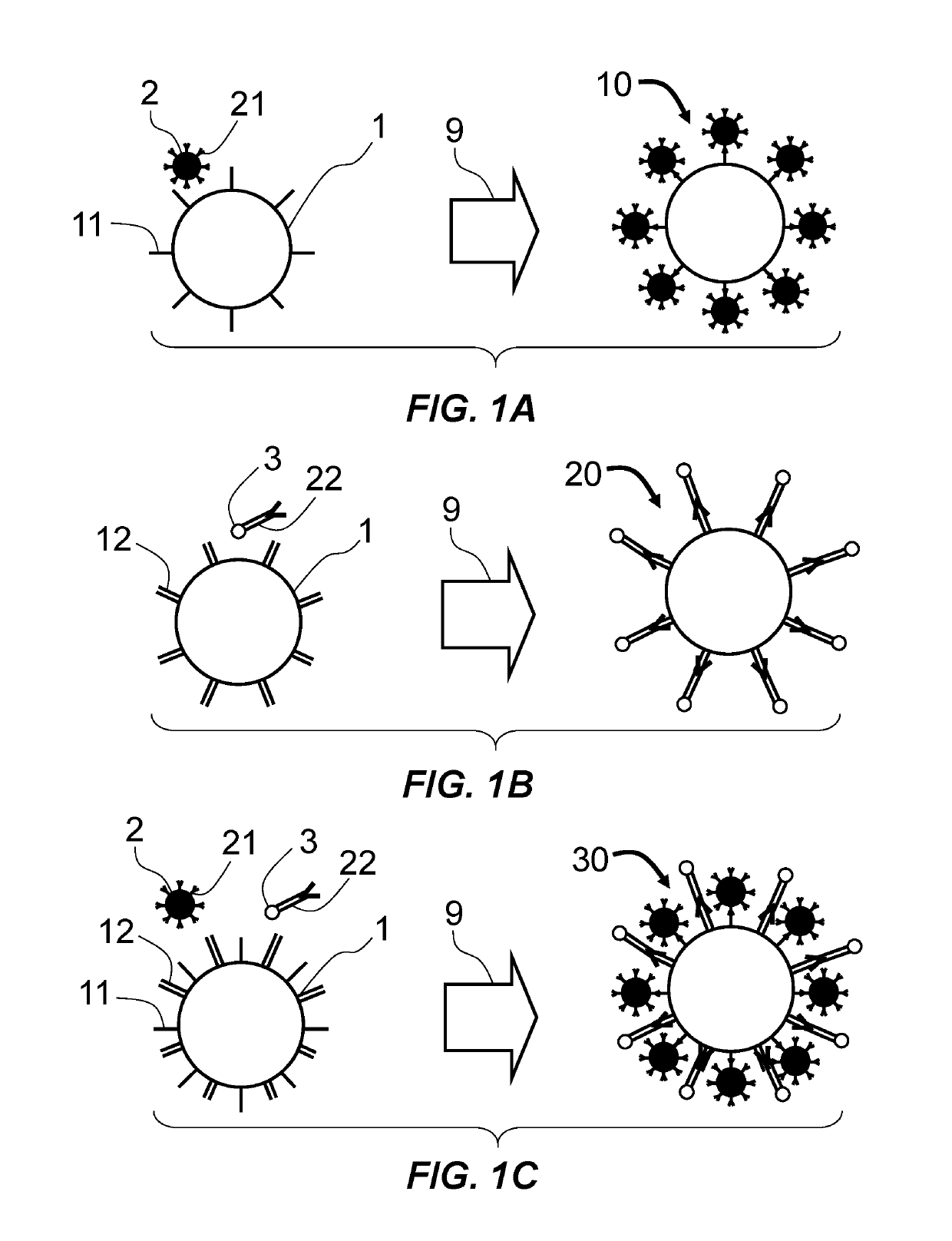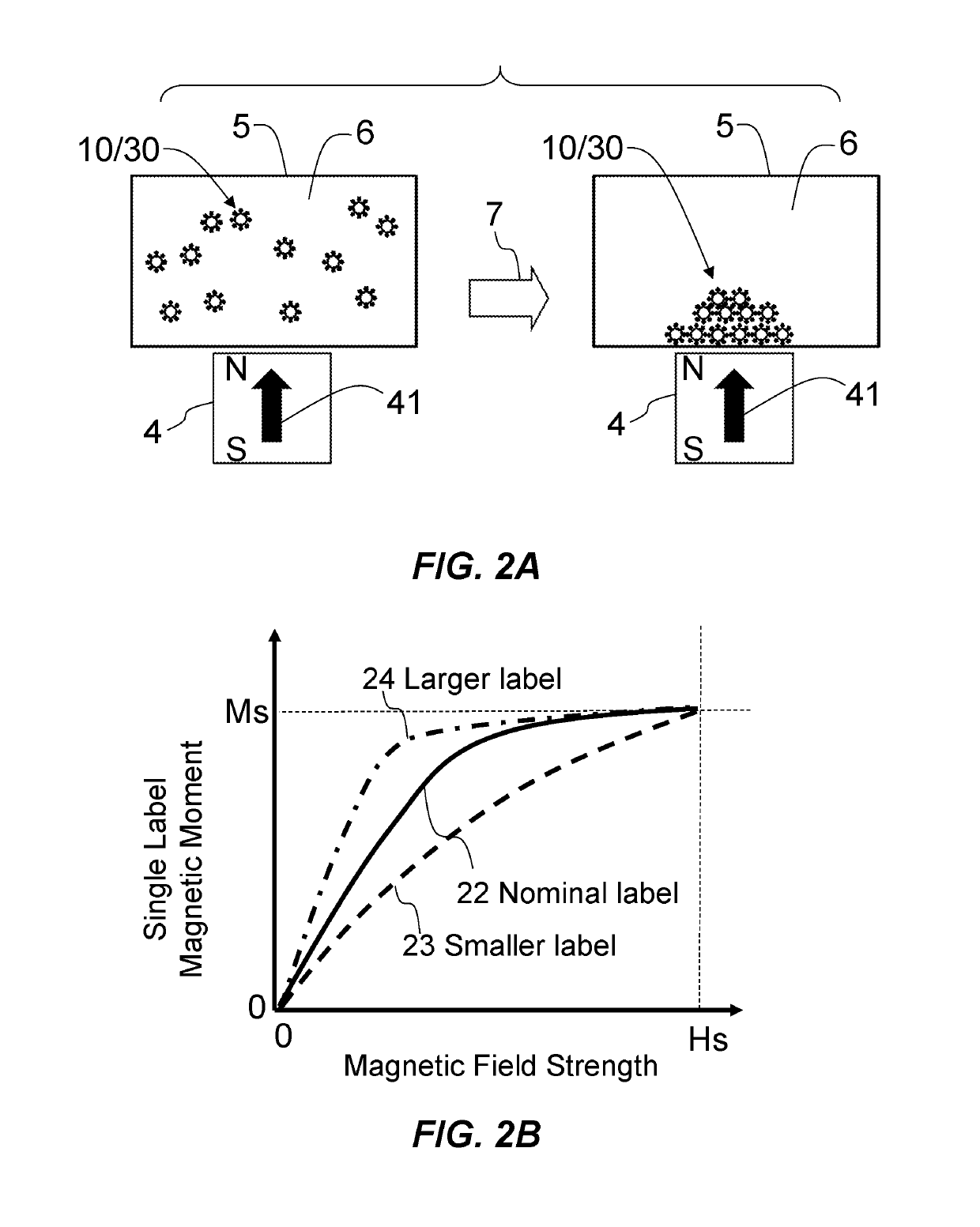Microfluidic device and method of use
a microfluidic device and microfluidic technology, applied in the field of biological entity separation methods and apparatuses, can solve the problems of cell b>10, 2a has limitations in actual applications, and conventional methods, and achieves the effect of high flow ra
- Summary
- Abstract
- Description
- Claims
- Application Information
AI Technical Summary
Benefits of technology
Problems solved by technology
Method used
Image
Examples
first embodiment
[0191]FIG. 4 shows a cross-sectional view of a magnetic separation device (“MAG”) of the current invention. MAG 121 is composed of two magnetic field producing poles, pole 102 and pole 103. Each of the poles 102 and 103 is composed of soft magnetic material, which may include one or more elements of iron (Fe), cobalt (Co), nickel (Ni), iridium (Ir), manganese (Mn), neodymium (Nd), boron (B), samarium (Sm), aluminum (Al). Pole 102 has a magnetic flux collection end 1023 and a tip end 1021, where shape of the pole 102 is converging from the flux collection end 1023 towards the tip end 1021. In FIG. 4, flux collection end 1023 is a flat surface which is contacting, or in proximity to, the North Pole (“N”) surface of a permanent magnet 104. Permanent magnet 104 has a magnetization as shown by arrow 1041 in FIG. 4 which points from the South Pole (“S”) surface of to the N surface of the magnet 104. Magnetization 1041 produces magnetic field in free space, which can be described as flux l...
second embodiment
[0198]FIG. 8A is a cross-sectional view of MAG of current invention. MAG 122 in FIG. 8A is substantially similar as MAG 121, except a soft magnetic shield 106 is attached to the S surface of magnetic 104 and N surface of magnet 105. Magnetic flux from S surface of magnet 104 and N surface of magnet 105 forms closure path within the soft magnetic shield 106. MAG 122 compared to MAG 121 will have less magnetic flux leakage outside of the MAG 122 structure, where magnetic flux generated by magnets 104 and 105 are mainly confined within the soft magnetic material body of poles 102 and 103, and shield 106. MAG 122 is preferred in applications where magnetic interference from MAG 122 to other surrounding instrument or equipment is desired to be minimized.
third embodiment
[0199]FIG. 8B is a cross-sectional view of MAG of current invention.
[0200]Compared to MAG 121, MAG 123 of FIG. 8B incorporates only one permanent magnet 108, which is attached to both poles 102 and 103, where flux from N surface of magnet 108 and flux from S surface of magnetic 108 is conducted by poles 102 and 103 to produce MAG 123 gap field by tip ends 1021 and 1031. Compared to MAG 121, magnetic flux generated by magnet 108 is mainly confined within the soft magnetic material body of poles 102 and 103, and MAG 123 is comparatively easier to assemble and produces less magnetic flux leakage.
[0201]FIG. 9 shows a cross-sectional view of the first embodiment MAG 121 being used for magnetic separation in combination with a flexible channel 201. FIG. 9 is similar to FIG. 4, except that the rigid channel 101 is replaced with a flexible channel 201. Flexible channel 201 may assume any shape, including a circular shape tubing form, at its non-deformed state, but can be deformed into other...
PUM
| Property | Measurement | Unit |
|---|---|---|
| size | aaaaa | aaaaa |
| size | aaaaa | aaaaa |
| size | aaaaa | aaaaa |
Abstract
Description
Claims
Application Information
 Login to View More
Login to View More - R&D
- Intellectual Property
- Life Sciences
- Materials
- Tech Scout
- Unparalleled Data Quality
- Higher Quality Content
- 60% Fewer Hallucinations
Browse by: Latest US Patents, China's latest patents, Technical Efficacy Thesaurus, Application Domain, Technology Topic, Popular Technical Reports.
© 2025 PatSnap. All rights reserved.Legal|Privacy policy|Modern Slavery Act Transparency Statement|Sitemap|About US| Contact US: help@patsnap.com



